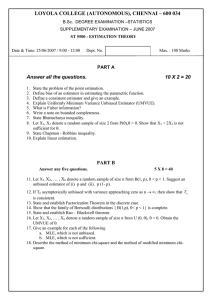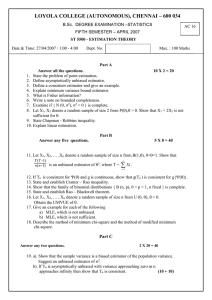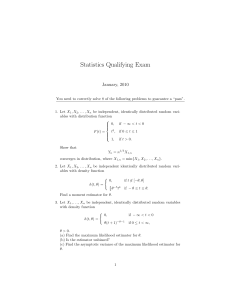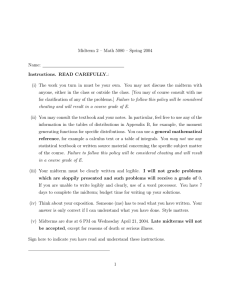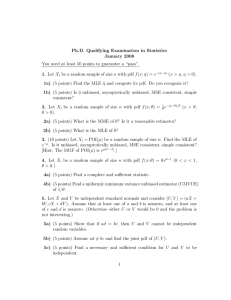ST 5500 - Loyola College
advertisement
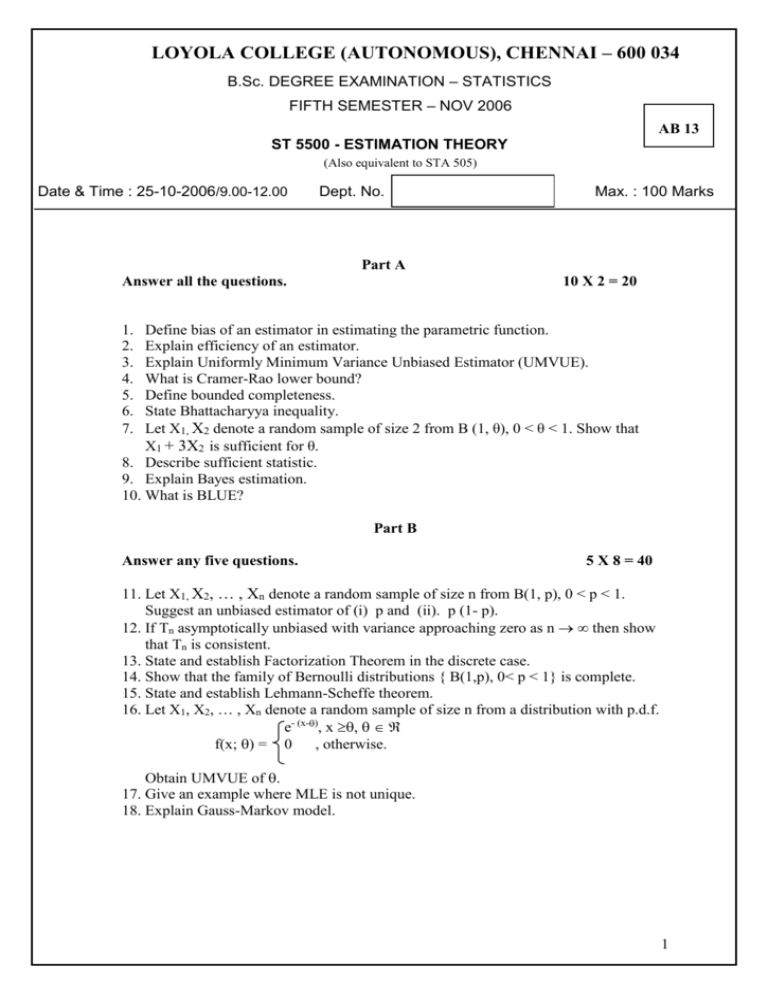
LOYOLA COLLEGE (AUTONOMOUS), CHENNAI – 600 034
B.Sc. DEGREE EXAMINATION – STATISTICS
FIFTH SEMESTER – NOV 2006
AB 13
ST 5500 - ESTIMATION THEORY
(Also equivalent to STA 505)
Date & Time : 25-10-2006/9.00-12.00
Dept. No.
Max. : 100 Marks
Part A
Answer all the questions.
10 X 2 = 20
1.
2.
3.
4.
5.
6.
7.
Define bias of an estimator in estimating the parametric function.
Explain efficiency of an estimator.
Explain Uniformly Minimum Variance Unbiased Estimator (UMVUE).
What is Cramer-Rao lower bound?
Define bounded completeness.
State Bhattacharyya inequality.
Let X1, X2 denote a random sample of size 2 from B (1, θ), 0 < θ < 1. Show that
X1 + 3X2 is sufficient for θ.
8. Describe sufficient statistic.
9. Explain Bayes estimation.
10. What is BLUE?
Part B
Answer any five questions.
5 X 8 = 40
11. Let X1, X2, … , Xn denote a random sample of size n from B(1, p), 0 < p < 1.
Suggest an unbiased estimator of (i) p and (ii). p (1- p).
12. If Tn asymptotically unbiased with variance approaching zero as n then show
that Tn is consistent.
13. State and establish Factorization Theorem in the discrete case.
14. Show that the family of Bernoulli distributions { B(1,p), 0< p < 1} is complete.
15. State and establish Lehmann-Scheffe theorem.
16. Let X1, X2, … , Xn denote a random sample of size n from a distribution with p.d.f.
e- (x-), x ,
f(x; ) = 0
, otherwise.
Obtain UMVUE of .
17. Give an example where MLE is not unique.
18. Explain Gauss-Markov model.
1
Part C
Answer any two questions.
2 X 20 = 40
19. a). Let X1, X2, … ,.Xn denote a random sample of size n from P(), >0. Suggest
an unbiased estimator of i)
ii) 5 + 7.
b). If Tn is consistent estimator for ( ) and g is continuous then show that g(Tn)
is consistent for g( ( ) ).
(10 +10)
20. a). Show that UMVUE is essentially unique.
b). Obtain CRLB for estimating in case of
1
f(x ; ) =
, - < x < and - < < ,
2
[1 + (x - ) ]
based on a random sample of size n.
(10 +10)
21. a). State and establish Chapman – Robbins inequality.
b). Describe the method of moments with an illustration.
(12 + 8)
22. a). Let X1, X2, … , Xn denote a random sample of size n from N (, 2). Obtain
MLE of = (, 2).
b). Illustrate the method of moments with the help of G (, p).
(12 + 8)
*********************
*********
2

